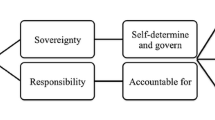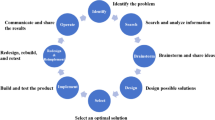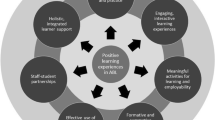Abstract
Traditional education seems to gradually and moderately make way for self-directed and student-centred learning strategies that will efficiently enable students to reach their full potentials and will sufficiently prepare them for their upcoming professional careers. Problem-Based Learning (PBL) is such a strategy, since it enables active participation by shifting the focus from the delivery of knowledge to its creation by the students, in their endeavour to implement problem-based projects. PBL is more commonly used in project-oriented courses, where students have to not only build but also apply new knowledge in real world contexts and therefore familiarize themselves with work conditions. Online technologies, such as cognitive tools, are able to harmonize this shift by visualizing some of the more demanding steps of PBL as well as facilitating collaboration and knowledge building. The aim of this paper is to investigate the incorporation of cognitive technologies in project-oriented courses, using a Blended PBL strategy. To this end, we implement our findings in a Project Management postgraduate course. Based on the gathered results, we propose a framework that can guide the design of project-oriented courses and we argue that its adaptation can exploit the identified strengths and avoid the weaknesses and lead to successful and immersive learning processes.






Similar content being viewed by others
References
Allen, D. E., Duch, B., Groh, S., Watson, G. B., & White, H. B. (2003). Professional development of University Professors: Case study from the University of Delaware. International conference Docencia Universitaria en Tiempos de Cambio [University Teaching in Times of Change] at Pontificia Universidad Catσlica del Perϊ, Lima.
Alonso, F., López, G., Manrique, D., & Viñes, J. M. (2005). An instructional model for web-based e-learning education with a Blended Learning process approach. British Journal of Educational Technology, 36, 217–235.
Armstrong, E. G. (1997). A hybrid model of Problem-Based Learning. In D. Boud & G. I. Feletti (Eds.), The challenge of Problem-Based Learning (2nd ed., pp. 137–50). London: Kogan Page.
Baker, M. (1992). Modeling negotiation in intelligent teaching dialogue. In R. Moyse & M. T. Elsom-Cook (Eds.), Knowledge negotiation. London: Academic Press Limited.
Barron, B., Schwartz, D. L., Vye, N. J., Moore, A., Petrosino, T., Zech, L., & Bransford, J. D. (1998). Doing with understanding: lessons from research on problem and project based learning. The Journal of the Learning Sciences, 7, 271–311.
Barrows, H. S., & Tamblyn, R. M. (1980). Problem-Based Learning: An approach to medical education. Springer Series on Medical Education. Volume 1.
Beaumont, C., Owens, T., Barrett-Baxendale, M., & Norton, B. (2008) Blended Problem-Based Learning for widening participation: a case study. ITALICS (Innovation in Teaching and Learning in Information and Computer Sciences), 7 (1). ISSN 1473–7507
Bonk, C. J., & Graham, C. R. (2006). In C. Bonk, & C. Graham (Eds.), The handbook of blended learning: Global perspectives, local designs. New York: Pfeiffer.
Boud, D. (1985). Problem-based learning in perspective. In D. Boud (Ed.), Problem-Based Learning in Education for the Professions. Sydney: HERDSA.
Bridges, E. M., & Hallinger, P. (1992). Problem-based learning for administrators. Eugene, OR: University of Oregon, ERIC Clearinghouse on Educational Management.
Brodie, L., & Borch, O. (2004). Choosing PBL paradigms: Experience and methods of two universities. Toowoomba: Australasian Association of Engineering Educators Conference.
Brown, A. L., & Campione, J. C. (1996). Psychological theory and the design of innovative learning environments. On procedures, principles, and systems. In L. Schauble & R. Glaser (Eds.), Innovation in learning: New environments for education (pp. 289–325). Hillsdale: Lawrence Erlbaum Associates.
Cortina, J. M. (1993). What is coefficient alpha? An examination of theory and applications. Journal of Applied Psychology, 78, 98–104.
Dahlgren, M., & Dahlgren, L. (2002). Portraits of PBL: students’ experiences of the characteristics of problem based learning in physiotherapy, computer engineering and psychology. Instructional Science, 30, 111–127.
Dalsgaard, C., & Godsk, M. (2007). Transforming traditional lectures into problem-based Blended Learning: challenges and experiences, Open Learning. The Journal of Open, Distance and e-Learning, 22(1), 29–42.
David, T., Patel, L., Burdett, K., & Rangachari, P. (1999). Problem-Based Learning in medicine: A practical guide for students and teachers. London: Royal Society of Medicine Press.
Davis, F. D., Bagozzi, R. P., & Warshaw, P. R. (1989). User acceptance of computer technology: a comparison of two theoretical models. Management Science, 35(8), 982–1003.
Derntl, M., Motschnig-Pitrik, R. (2004). Patterns for blended, person-centered learning: strategy, concepts, experiences, and evaluation. Proceedings of 2004 ACM Symposium on Applied Computing, Nicosia, pp. 916–923.
Donnelly, R. (2010a). Interaction analysis in a ‘Learning by Doing’ problem-based professional development context. Computers & Education, 55(3), 1357–1366. doi:10.1016/j.compedu.2010.06.010.
Donnelly, R. (2010b). Harmonizing technology with interaction in blended Problem-Based Learning. Computers & Education, 54(2), 350–359.
Drewitz, Ι. (2009). Evaluation of e-learning platforms. eWorks, mSysTech. Available at: http://www.eworks.de/research/2009/03/Evaluierung-E-Learning-Plattformen/Evaluation_of_e-learning_platforms.pdf.
Grant, M. (2002), Meridian: A Middle School Computer Technologies Journal a service of NC State University, Raleigh, NC, Volume 5, Issue 1 ISSN 1097 9778 (MEST)) http://www.ncsu.edu/meridian/win2002/514/index.html Accessed 23 April 2012
Herrera, L., Mendoza, N., & Maldonado, G. (2008). Benchmarking e-learning platforms: the best choice from the first noise. In J. Luca & E. Weippl (Eds.), Proceedings of World Conference on Educational Multimedia, Hypermedia and Telecommunications 2008 (pp. 5962–5969). Chesapeake: AACE.
Hmelo-Silver, C. (2004). Problem-Based Learning: what and how do students learn? Educational Psychology Review, 16(3), 10.1023/B:EDPR.0000034022.16470.f3.
Hoic-Bozic, N., Mornar, V., & Boticki, I. (2009). A Blended Learning approach to course design and implementation. IEEE Transactions on Education, 52(1), 19–30. doi:10.1109/TE.2007.914945.
Hung, W. (2011). Theory to reality: a few issues in implementing Problem-Based Learning. Educational Technology Research and Development, 59(4), 10.1007/s11423-011-9198-1.
Jonassen, D. H., & Reeves, T. C. (1996). Learning with technology: using computers as cognitive tools. In D. H. Jonassen (Ed.), Handbook of research for educational communications and technology (1st ed.). New York: Macmillan.
Kerres, M., & De Witt, C. (2003). A didactical framework for the design of Blended Learning arrangements. Journal of Educational Media, 28(2–3), 101–113.
Kim, B., & Reeves, T. C. (2007). Reframing research on learning with technology: in search of the meaning of cognitive tools. Instructional Science, 35(3), 207–256. doi:10.1007/s11251-006-9005-2.
Kim, P., Hong, J. S., Bonk, C., & Lim, G. (2011). Effects of group reflection variations in project-based learning integrated in a Web 2.0 learning space. Interactive Learning Environments, 19(4), 333–349.
Kolmos, A., Fink, F. K., & Krogh, L. (Eds.). (2004). The Aalborg PBL model-progress, diversity and challenges. Aalborg: Aalborg University Press.
Konstantinidis, S.T., Bamidis, P.D., Kaldoudi, E. (2009). Active Blended Learning in medical education—combination of WEB 2.0 problem based learning and computer based audience response systems. Computer-Based Medical Systems. CBMS 2009. 22nd IEEE International Symposium on, vol., no., pp.1–6, 2–5 Aug. 2009. doi: 10.1109/CBMS.2009.5255412.
Krajcik, J. S., Blumenfeld, P. C., Marx, R. W., & Soloway, E. (1994). A collaborative model for helping middle-grade science teachers learn project-based instruction. The Elementary School Journal, 94, 483–497.
Lengyel, P., Herdon, Μ., & Szilágyi, R. (2006). Comparison of Moodle and ATutor LMSs. Summer University on Information Technology in Agriculture and Rural Development (pp. 21–28). Debrecen.
Liu, L., & Richmond, A. (2005). Project Based Learning in Information Technology courses. In C. Crawford et al. (Eds.), Proceedings of Society for Information Technology & Teacher Education International Conference 2005 (pp. 3282–3287). Chesapeake: AACE.
Lo, H.-C. (2009). Utilizing computer-mediated communication tools for Problem-Based Learning. Journal of Educational Technology & Society, 12(1), 205–213.
Lu, J., Lajoie, S. P., & Wiseman, J. (2010). Scaffolding Problem-Based Learning with CSCL tools. International Journal of Computer-Supported Collaborative Learning, 5(3), 283–298. doi:10.1007/s11412-010-9092-6.
Mandl, H., Gruber, H., & Renkl, A. (1996). Communities of practice toward expertise: Social foundation of university instruction. In P. B. Baltes & U. M. Staudinger (Eds.), Interactive minds. Life-span perspectives on the social foundation of cognition (pp. 394–412). Cambridge: Cambridge University Press.
Mauffette, Y. (2001). PBL in Science Education: A Curriculum Reform in Biology at University of Quebec in Montreal. PBL insight: A newsletter for undergraduate Problem-Based Learning from Samford University. http://www4.samford.edu/pubs/pbl/pblvol4.1.pdf. Accessed 24 August 2011.
Mertens, D. M. (1998). Research methods in education and psychology: Integrating diversity with quantitative and qualitative approaches. Thousand Oaks: Sage.
Moesby, E. (2002). From pupil to student—a challenge for universities: an example of a PBL study programme. Global Journal of Engineering Education, 6(2), 145–152.
Murray-Harvey, R., & Slee, P. (2000). Problem Based Learning in teacher education: Just the beginning! Paper presented at Australian Association for Research in Education. Sydney, December 4–6.
Nelson, W. A. (2003). Problem-solving through design. In D. S. Knowlton & D. C. Sharp (Eds.), Problem-Based Learning in the information age, new directions for teaching and learning, No. 95 (pp. 39–44). San Francisco: Jossey Bass.
New South Wales Department of Education and Training. (2005). Blended Learning. Learning Technologies. Retrieved from http://www.schools.nsw.edu.au/learning/yrk12focusareas/learntech/blended/index.php. Accessed 23 April 2012.
Northwood, M. D., Northwood, D. O., & Northwood, M. G. (2003). Problem-Based Learning: from the health sciences to engineering to value-added in the workplace. Global Journal of Engineering Education, 7, 157.
Nussbaum, E.M., & Bendixen, L.D. (2002) The effect of personality, ability, & epistemological beliefs on students’nargumentation behavior. Poster presented at the American Educational Research Association Annual Meeting, New Orleans.
Oh, S., & Jonassen, D. H. (2007). Scaffolding online argumentation during problem solving. Journal of Computer Assisted Learning, 23, 95–110.
Oliver, R. (2005). Using a Blended Learning approach to support Problem-Based Learning with first year students in large undergraduate classes. In C. Looi, D. Joassen, & M. Ikeda (Eds.), Towards sustainable and scalable educational innovations informed by the learning sciences (pp. 848–851). Amsterdam: Ios Press.
Oscar, A.-V., Xabier, N.-C., Oscar, B.-A., de Acedo Lizarraga, M. L. S., & de Acedo Baquedano, M. T. S. (2011). Evaluation of computer tools for idea generation and team formation in project-based learning. Computers & Education, 56(3), 700–711.
Perrenet, J. C., Bouhuijs, P. A. J., & Smits, J. G. M. M. (2000). The suitability of Problem-Based Learning for engineering education: theory and practice. Teaching in Higher Education, 5(3), 345–358. doi:10.1080/713699144.
Robertson, B., Elliot, L., & Robinson, D. (2007). Cognitive tools. In M. Orey (Ed.), Emerging perspectives on learning, teaching, and technology. Retrieved from http://projects.coe.uga.edu/epltt. Accessed 23 April 2012.
Rocaa, J. C., Chiub, C., & Martinez, F. J. (2006). Understanding e-learning continuance intention: an extension of the Technology Acceptance Model. International Journal of Human-Computer Studies, 64(8), 683–69. doi:10.1016/j.ijhcs.2006.01.003.
Saarinen-Rahiika, H., & Binkley, J. M. (1998). Problem-Based Learning in physical therapy: a review of the literature and overview of the McMaster University experience. Journal of the American Physical Therapy Association, 78(2), 195–207. discussion 207–211.
Scardamalia, M., & Bereiter, C. (2003). Knowledge building. In Encyclopedia of education, second edition (pp. 1370–1373). New York: Macmillan Reference.
Schultz, N., & Christensen, H. P. (2004). Seven-step Problem-Based Learning in an interaction design course. European Journal of Engineering Education, 29(4), 533–541. doi:10.1080/03043790410001716248.
Stinson, J. E., & Milter, R. G. (1996). Problem-Based Learning in business education: curriculum design and implementation issues. New Directions for Teaching and Learning, 1996, 33–42.
Thomas, J. W. (2000). A review of research on project-based learning. San Rafael: Autodesk Foundation.
van Joolingen, W. (1999). Cognitive tools for discovery learning. International Journal of Artificial Intelligence and Education, 10, 385–397.
Yeh, Y. (2010). Integrating collaborative PBL with Blended Learning to explore preservice teachers’ development of online learning communities. Teaching and Teacher Education, 26(8), 1630–1640. November 2010.
Author information
Authors and Affiliations
Corresponding author
Appendix
Appendix
Question | Cronbach’s a | Mean | SD |
|---|---|---|---|
Perceived cognitive absorption | 0.758 | ||
Time flies when I am using the e-learning system | 3.57 | 0.938 | |
I have fun interacting with the e-learning system | 3.67 | 0.745 | |
I enjoy using the e-learning system | 3.50 | 0.76 | |
Perceived ease of use | 0.869 | ||
Learning to operate the e-learning service is easy for me | 4.07 | 0.730 | |
It is easy for me to become skilful at using the e-learning service | 4.21 | 0.893 | |
My interaction with the e-learning service is clear and understandable | 4.29 | 0.726 | |
I found it easy to document my tasks | 4.00 | 0.603 | |
I found it easy to analyze problems with the thematic block tool | 3.75 | 1.138 | |
I found it easy to voice my arguments in the argumentation tool | 3.50 | 1.087 | |
Perceived Internet self-efficacy | 0.84 | ||
I feel confident in the e-learning system documenting my tasks/to do work | 4.09 | 0.701 | |
I feel confident in the e-learning system exchanging messages with other users in the argumentation tool | 3.54 | 0.967 | |
I feel confident in the e-learning system by analyzing ideas with the thematic block tool | 3.50 | 1.087 | |
I feel confident in the e-learning system posting thoughts in discussion blogs | 3.75 | 0.866 | |
Satisfaction | 0.952 | ||
I am satisfied with the performance of the e-learning service | 3.67 | 0.842 | |
I am pleased with the experience of using the e-learning service | 3.50 | 0.855 | |
Rights and permissions
About this article
Cite this article
Tambouris, E., Zotou, M. & Tarabanis, K. Towards designing cognitively-enriched project-oriented courses within a blended problem-based learning context. Educ Inf Technol 19, 61–86 (2014). https://doi.org/10.1007/s10639-012-9209-9
Published:
Issue Date:
DOI: https://doi.org/10.1007/s10639-012-9209-9




